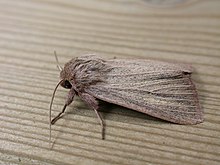Mythimna pudorina, the striped wainscot, is a species of moth of the family Noctuidae. It is found in the Palearctic realm (Europe and all of Russia to Japan). Also Armenia, Asia Minor and eastern Siberia.
| Striped wainscot | |
|---|---|

| |
| Scientific classification | |
| Domain: | Eukaryota |
| Kingdom: | Animalia |
| Phylum: | Arthropoda |
| Class: | Insecta |
| Order: | Lepidoptera |
| Superfamily: | Noctuoidea |
| Family: | Noctuidae |
| Genus: | Mythimna |
| Species: | M. pudorina
|
| Binomial name | |
| Mythimna pudorina (Denis & Schiffermüller, 1775)
| |
Technical description and variation
editThe wingspan is 35–38 mm. Forewing flesh coloured ochreous densely dusted with grey atoms; the veins slightly paler; the upper half of cell and of submedian interval often paler without dusting, the streak in cell continued to margin; sometimes a darker streak in lower half of cell also continued to termen; hindwing dark grey, with pale fringe; -impudens Hbn. is a less marked grey form, without reddish tinge;- rufescens Tutt is a rare British form, bright rosy red, with pale grey dusting; striata Tutt darker, with the grey intervals blackish.[1] See also Hacker et al.[2]
Biology
editThe moth flies from June to August depending on the location.
Larva dirty yellowish white; dorsal line white; subdorsal also white, edged above with black; 3 fine whitish lateral lines and a narrow grey stripe containing the black spiracles. The larvae feed on various grasses, such as purple moor grass, Phragmites and reed canary grass.[3]
References
edit- ^ Seitz, A. Ed., 1914 Die Großschmetterlinge der Erde, Verlag Alfred Kernen, Stuttgart Band 3: Abt. 1, Die Großschmetterlinge des palaearktischen Faunengebietes, Die palaearktischen eulenartigen Nachtfalter, 1914
- ^ Hermann Hacker, László Ronkay & Márton Hreblay: Noctuidae Europaeae vol. 4 Hadeninae I. Entomological Press, Sorø 2002, ISBN 87-89430-07-7
- ^ "Robinson, G. S., P. R. Ackery, I. J. Kitching, G. W. Beccaloni & L. M. Hernández, 2010. HOSTS – A Database of the World's Lepidopteran Hostplants. Natural History Museum, London".
External links
edit